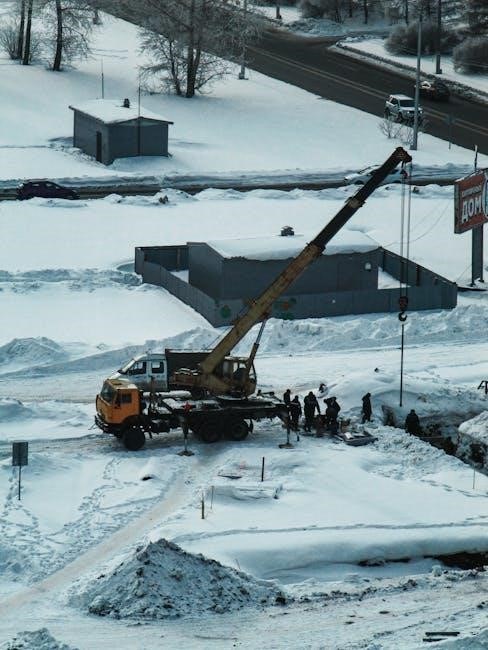Manual cranes are portable lifting devices operated without electric power‚ ideal for construction and manufacturing․ They offer efficiency and safety in lifting tasks‚ making them essential tools in various industries․

Types of Manual Cranes
Manual cranes are categorized into lever-operated and winch-operated types․ Lever-operated cranes use a lever for lifting‚ while winch-operated cranes rely on a hand-cranked winch for load movement‚ both offering portability and ease of use․
2․1 Lever-Operated Cranes
Lever-operated cranes are simple‚ portable devices that use a lever mechanism to lift loads․ They are ideal for small-scale applications due to their lightweight and ease of use․ These cranes typically consist of a fulcrum‚ lever arm‚ and a cable or chain system to lift loads․ The operator applies manual force to the lever‚ which amplifies the effort‚ allowing for efficient lifting․ Lever-operated cranes are commonly used in construction sites‚ workshops‚ and small manufacturing units where electric power is not available․ Their compact design makes them easy to transport and set up․ While they have lower load capacities compared to winch-operated cranes‚ they are preferred for their simplicity and cost-effectiveness․ Regular maintenance‚ such as lubricating moving parts and checking cable integrity‚ ensures optimal performance and safety․ Lever-operated cranes are a reliable choice for manual lifting needs in various industries․
2․2 Winch-Operated Cranes
Winch-operated cranes are manual lifting devices that utilize a winch system to hoist loads․ They are designed for heavier-duty applications compared to lever-operated cranes․ The winch consists of a drum and a handle‚ which the operator turns to wind the cable or chain around the drum‚ lifting the load․ These cranes are known for their robust construction and higher load capacities‚ making them suitable for construction sites‚ manufacturing facilities‚ and workshops․ Winch-operated cranes often feature adjustable heights and portable designs‚ allowing for versatility in different work environments․ While they require more physical effort than lever-operated cranes‚ they are preferred for their durability and ability to handle larger loads․ Regular lubrication of the winch mechanism and inspection of the cable are essential for maintaining performance and safety․ Winch-operated cranes are a reliable choice for manual lifting tasks that require more strength and capacity․

Safety Guidelines
Always ensure proper training‚ regular equipment inspections‚ and adherence to load limits․ Use personal fall protection and maintain stable ground conditions to prevent accidents during crane operation․
3․1 Pre-Operation Checks
Before using a manual crane‚ conduct a thorough inspection to ensure all components are in good condition․ Check for wear on wire ropes‚ proper lubrication of moving parts‚ and functionality of brakes and locks․ Verify that the crane is level and stable‚ and the ground is firm and even․ Ensure all bolts and nuts are tightened securely․ Review the load chart to confirm the crane’s capacity for the intended lift․ Additionally‚ inspect personal fall protection equipment and ensure proper communication among the team․ Perform a test lift with a light load to ensure smooth operation․ Document any defects or issues and address them before proceeding․ Regular maintenance and adherence to manufacturer guidelines are crucial for safe and reliable crane performance․
3․2 Load Capacity
Understanding and adhering to the load capacity of a manual crane is critical for safe and efficient operation․ The load capacity‚ often specified on the crane’s nameplate or in the manufacturer’s manual‚ indicates the maximum weight the crane can safely lift․ Exceeding this limit can result in equipment failure or serious safety hazards․ Always verify the load’s weight before lifting and ensure it matches the crane’s rated capacity․ Use load charts to determine the crane’s capacity at different angles and heights‚ as these factors can significantly affect lifting ability․ Never overload the crane‚ and consider factors like uneven terrain or wind conditions that may reduce its effective capacity․ Regular inspections and maintenance are essential to maintain the crane’s load-bearing integrity․ Follow all manufacturer guidelines to ensure safe and reliable performance․ Ignoring load capacity limits can lead to accidents‚ making it a cornerstone of crane safety protocols․

Operation and Maintenance
Manual cranes require careful operation and regular maintenance to ensure optimal performance and longevity․ Proper setup‚ smooth lifting‚ and lowering techniques are essential for safe and efficient load handling․

4․1 Steps to Operate
Operating a manual crane involves several structured steps to ensure safety and efficiency․ First‚ thoroughly inspect the crane and its components‚ such as wire ropes and pulleys‚ for any damage or wear․ Next‚ position the crane on a stable‚ level surface to prevent tipping․ Attach the load securely using appropriate lifting gear‚ ensuring it is properly balanced․ Before lifting‚ communicate with your team to coordinate the operation․ Slowly raise the load using the crane’s manual controls‚ maintaining constant control throughout the process․ Avoid sudden movements to prevent swaying or dropping the load․ Once the load is in place‚ carefully lower it to the desired location․ After operation‚ secure the crane and store it properly to maintain its condition․ Always follow the manufacturer’s guidelines for optimal performance and safety․
4․2 Maintenance Tips
Regular maintenance is crucial to ensure the optimal performance and longevity of manual cranes․ Start by inspecting wire ropes for frays‚ kinks‚ or corrosion‚ replacing them if damaged․ Lubricate moving parts‚ such as pulleys and gears‚ to reduce friction and prevent wear․ Check the crane’s identification plate for the serial number and refer to the manufacturer’s manual for specific maintenance schedules․ Clean the crane regularly to remove dirt and debris that could interfere with its operation․ Inspect the brake system and ensure it functions correctly to prevent accidental load movement․ Tighten all bolts and fasteners periodically to maintain structural integrity․ Keep the crane stored in a dry‚ protected area when not in use to avoid rust․ Always follow the manufacturer’s guidelines for lubrication and replacement of parts․ Proper maintenance not only extends the crane’s lifespan but also enhances workplace safety and efficiency․
Applications
Manual cranes are widely used in construction and manufacturing industries for lifting heavy loads․ They are versatile tools‚ ideal for various tasks that require precise and safe material handling․
5․1 Construction
Manual cranes play a vital role in construction sites‚ enabling the safe and efficient lifting of heavy materials like steel beams‚ concrete blocks‚ and equipment․ Their portability and ease of operation make them ideal for smaller-scale projects or areas with limited space․ These cranes are often used to lift materials to higher floors or move heavy loads across the site․ They are particularly useful in scenarios where electrical power is unavailable or impractical․ Proper training and adherence to safety guidelines are essential to ensure the crane’s stability and prevent accidents․ Regular maintenance‚ such as checking wire ropes and lubricating moving parts‚ ensures optimal performance․ By providing a reliable and manual lifting solution‚ these cranes contribute significantly to the efficiency and safety of construction projects․
5․2 Manufacturing
Manual cranes are extensively used in manufacturing facilities to handle heavy machinery‚ components‚ and tools․ Their compact design and manual operation make them ideal for precise lifting tasks in tight spaces․ In assembly lines‚ these cranes assist in positioning parts accurately‚ ensuring production efficiency․ They are also utilized for moving equipment between workstations‚ reducing downtime and enhancing workflow․ Additionally‚ manual cranes are employed in maintenance tasks‚ such as lifting motors or pumps for repair․ Their portability and ease of use allow workers to maneuver heavy loads safely‚ even in areas with limited access to electricity․ Regular maintenance‚ such as inspecting wire ropes and lubricating components‚ ensures reliable performance․ By providing a cost-effective and reliable lifting solution‚ manual cranes play a crucial role in maintaining the productivity and safety of manufacturing operations․
Choosing the Right Crane
Selecting the appropriate manual crane involves considering load capacity‚ workspace constraints‚ and portability․ Ensure the crane matches the task requirements for safe and efficient operation in various environments․
6․1 Factors to Consider
When selecting a manual crane‚ several factors must be evaluated to ensure optimal performance and safety․ Load capacity is paramount‚ as exceeding the crane’s limit can lead to structural failure․ The work environment also plays a crucial role—cranes designed for indoor use may not withstand harsh outdoor conditions․ Portability is another key consideration‚ especially for applications requiring frequent relocation․ Additionally‚ operational ease and durability should be assessed to ensure the crane can handle repeated use without compromising performance․ Finally‚ maintenance requirements and compliance with safety standards must be verified to ensure long-term reliability and adherence to industry regulations․
Manual cranes are essential tools in various industries‚ offering a blend of efficiency and portability․ Their versatility makes them suitable for construction‚ manufacturing‚ and other sectors requiring precise lifting solutions․ Proper usage‚ adherence to safety guidelines‚ and regular maintenance are crucial for optimal performance and longevity․ By understanding the types‚ applications‚ and factors to consider‚ users can maximize the benefits of manual cranes while minimizing risks․ Their cost-effectiveness and reliability make them a valuable asset in many operations․ Always prioritize safety and follow established protocols to ensure successful outcomes․ Manual cranes continue to be indispensable in modern workflows‚ proving their worth through durability and adaptability;
